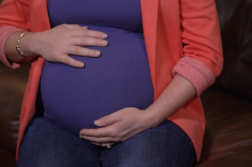ST. LOUIS, Mo. (Ivanhoe Newswire) – Brain tumors are the most common solid tumors in children. In fact, approximately 4,000 children will be diagnosed with brain tumor each year. The five-year survival rate in kids is 74 percent. But the younger the child, the chances of survival decrease, so what are the odds a child will survive when the brain tumor develops before birth?
Watching her little girl swing and slide, climb and walk is all Emily Murray has dreamed of.
“I found out I was pregnant right before the pandemic,” Emily says.
A single woman who chose fertility treatments to start her dream of having a family, until an ultrasound at 36 weeks showed a mass in the middle of baby Elizabeth’s brain.
Pediatric neurologist at WashU/St. Louis Children’s Hospital, Dr. Jennifer Strahle explains, “Elizabeth’s story is quite unique in that her tumor was found in utero, so, we detected it before she was even born.”
The age, size, and location of the tumor were extremely rare.
“A teratoma is a type of tumor that contains multiple types of tissues. So, it can have hair and teeth, and tissues from all over,” Dr. Strahle further explains.
Elizabeth’s tumor was extremely large – about the size of a grapefruit. Born with fluid on the brain, Elizabeth started having seizures.
Dr. Strahle adds, “Before we were able to take out the tumor, we had to perform surgery to drain those cysts.”
Then when she was strong enough, another surgery to remove the tumor.
“I said, ‘Well, hold on. How much of the tumor did you get?’ And she said, ‘Oh, I think we got the whole thing.’,” Emily recalls.
Doctors believe the tumor may have caused right side cerebral palsy.
“That side of her body has the most trouble with movement and muscle tone,” says neonatal neurologist at WashU/St. Louis Children’s Hospital, Dr. Lindsay Peglar Marsala.
Now, at two and a half, she’s making great strides, catching up cognitively with her peers, and the latest scans show that Elizabeth is tumor free – something her mom always dreamed of.
“It was scary, but it never felt impossible,” Emily expresses.
Elizabeth may always have weaker muscles on her right side, but it should not hold her back in any way. Doctors also have seen her brain mature and develop with time.
Contributors to this news report include: Marsha Lewis, Producer; Roque Correa, Videographer & Editor.
To receive a free weekly e-mail on medical breakthroughs from Ivanhoe, sign up at: http://www.ivanhoe.com/ftk
Source:
MEDICAL BREAKTHROUGHS
RESEARCH SUMMARY
TOPIC: MIRACLE BABY: BORN WITH A BRAIN TUMOR
REPORT: MB #5238
BACKGROUND: A brain tumor is an unusual growth or mass of cells within the brain. It can begin from the brain tissue itself or be caused from brain cancer that has spread from other areas of the body. These are known as metastatic tumors. Brain tumors can start as either cancerous or noncancerous, benign tumors. About one million Americans are living with a primary brain tumor and an estimated 18,990 people will die in 2023 from a malignant brain tumor. While they can affect any age group, certain kinds are more specific depending on age group and medical history. Brain tumors are the main cause of cancer-related death and the most diagnosed solid cancer in kids up to 14 years old.
(Sources: https://www.mayoclinic.org/diseases-conditions/brain-tumor/symptoms-causes/syc-20350084
https://braintumor.org/brain-tumors/about-brain-tumors/brain-tumor-facts/)
BRAIN TUMOR IN UTERO: Brain tumors that are diagnosed during a pregnancy are very rare but do exist. A diagnosis can be made through an ultrasound, but magnetic response imaging is necessary to show the relationship between the tumor and structures. Defining diagnosis must be made after birth as well, but a pregnancy diagnosis is important for parental health as well. For other diagnoses, if a doctor suspects a brain tumor, they will order various tests and procedures. Many include a neurological exam, head CT scan, brain MRIs, PET scans of the brain, sample tissue collection, and lab testing of the sample tissue.
(Sources: https://www.ncbi.nlm.nih.gov/pmc/articles/PMC4295174/
https://www.mayoclinic.org/diseases-conditions/brain-tumor/diagnosis-treatment/drc-20350088)
NEW TECHNOLOGY: Recent research has allowed doctors to see changes in genes, chromosomes, and proteins in brain tumor cells that can help guide treatment in children. New research allows doctors to test gene changes that can predict how likely they are to have a hopeful outcome. Some recent imaging and surveying technologies that have emerged are magnetic response spectroscopy, diffusion tensor imaging, fluorescence guided surgery, and different new surgery approaches.
(Source: https://www.cancer.org/cancer/types/brain-spinal-cord-tumors-children/about/new-research.html)
FOR MORE INFORMATION ON THIS REPORT, PLEASE CONTACT:
Judy Martin Finch Rachel Yann
martinju@wustl.edu Rachel.yann@bjc.org
If this story or any other Ivanhoe story has impacted your life or prompted you or someone you know to seek or change treatments, please let us know by contacting Marjorie Bekaert Thomas at mthomas@ivanhoe.com




